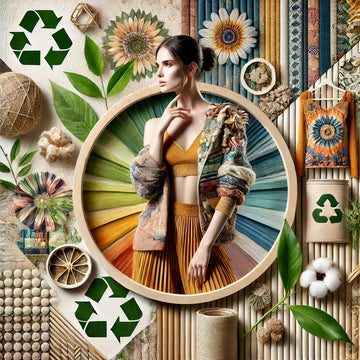Ultimate Guide to Sustainable Fashion: Trends, Materials, and Tips
by Muhammad Aman on Aug 13, 2024

Sustainable fashion is more than just a buzzword—it's a movement that is reshaping the global fashion industry. Driven by environmental concerns, ethical considerations, and the need for more responsible resource management, sustainable fashion is about creating clothing that is kind to both people and the planet. This guide will delve into the latest trends, explore the most eco-friendly materials, and offer practical tips to help you build a sustainable wardrobe.
Understanding Sustainable Fashion
What is Sustainable Fashion?
Sustainable fashion refers to clothing that is designed, manufactured, distributed, and used in ways that are environmentally friendly and socially responsible. It is a comprehensive approach that considers the entire lifecycle of a garment, from the sourcing of raw materials to its eventual disposal or recycling. The goal is to minimise the negative impact on the environment and ensure that the people involved in the production process are treated fairly.

The Importance of Sustainable Fashion
The fashion industry is one of the largest polluters in the world, responsible for significant water consumption, chemical pollution, carbon emissions, and textile waste. Sustainable fashion seeks to address these issues by promoting practices that reduce environmental impact and improve social equity.
- Environmental Impact: The fashion industry accounts for about 10% of global carbon emissions and is the second-largest consumer of the world’s water supply. Traditional textile production processes are highly resource-intensive and often involve harmful chemicals that pollute waterways and soil.
- Social Responsibility: Many workers in the fashion industry, particularly in developing countries, face poor working conditions, low wages, and unsafe environments. Sustainable fashion advocates for fair labor practices, including fair wages, safe working conditions, and the elimination of child and forced labor.

Trends in Sustainable Fashion
Sustainable fashion is not static; it evolves with technological advancements, consumer demand, and global trends. Here are some of the most influential trends shaping the industry today.
1. Circular Fashion
Circular fashion is a model that emphasizes extending the lifecycle of garments through practices such as recycling, upcycling, and resale. Instead of following a linear “take-make-dispose” approach, circular fashion aims to keep products in use for as long as possible, reducing waste and resource consumption.
- Recycling and Upcycling: Brands are increasingly using recycled materials, such as polyester made from plastic bottles, to create new garments. Upcycling involves repurposing old clothing into new designs, giving new life to items that would otherwise be discarded.
- Second-Hand and Vintage Shopping: The rise of resale platforms like ThredUp and Depop has made second-hand shopping more accessible and trendy. Buying vintage or pre-owned clothing reduces demand for new products and helps decrease the environmental footprint of fashion.

2. Slow Fashion
Slow fashion is a movement that encourages consumers to buy fewer, higher-quality pieces that will last longer. It is the antithesis of fast fashion, which prioritizes speed and low cost over quality and sustainability.
- Quality Over Quantity: Slow fashion promotes investing in well-made garments that are timeless, versatile, and durable. These pieces are designed to be worn for years, rather than being quickly discarded after a few wears.
- Artisan and Handmade Goods: Slow fashion often involves supporting small-scale artisans and designers who produce clothing using traditional techniques and sustainable materials. These items are typically made in limited quantities, reducing the risk of overproduction and waste.

3. Ethical Fashion
Ethical fashion focuses on the social impact of clothing production. It emphasizes fair labor practices, safe working conditions, and transparency in the supply chain. Ethical fashion brands often work closely with their suppliers to ensure that workers are treated with dignity and respect.
- Fair Trade Certification: Many ethical fashion brands seek Fair Trade certification, which guarantees that products are made under fair labor conditions. This certification also ensures that workers receive fair wages and work in safe environments.
- Transparency and Traceability: Consumers are increasingly demanding to know where their clothes come from and how they are made. Ethical brands provide transparency by sharing detailed information about their supply chains, including the sourcing of raw materials and the manufacturing processes.

Eco-Friendly Materials in Sustainable Fashion
Choosing eco-friendly materials is one of the most effective ways to reduce the environmental impact of clothing. Here are some of the most sustainable fabrics used in fashion today.
1. Organic Cotton
Organic cotton is grown without the use of synthetic pesticides, herbicides, or genetically modified organisms (GMOs). It uses less water than conventional cotton and supports healthier soil and ecosystems.
- Environmental Benefits: Organic cotton farming reduces water pollution and conserves water by using more sustainable irrigation methods. It also promotes biodiversity by avoiding harmful chemicals that can destroy local wildlife.
- Social Benefits: Farmers growing organic cotton often work in safer conditions and earn higher wages compared to those in conventional cotton farming. Organic farming practices also reduce the risk of health issues caused by exposure to toxic chemicals.

2. Hemp
Hemp is one of the most sustainable natural fibers available. It grows quickly, requires minimal water and pesticides, and improves soil health by replenishing vital nutrients.
- Versatility and Durability: Hemp fibers are incredibly strong and durable, making them ideal for creating long-lasting garments. The fabric is also naturally resistant to mold and ultraviolet light, making it a great choice for outdoor wear.
- Low Environmental Impact: Hemp requires significantly less water than cotton and can grow in a variety of climates, reducing the need for irrigation. Additionally, hemp absorbs large amounts of CO2 during its growth cycle, helping to offset carbon emissions.

3. Bamboo
Bamboo is a fast-growing plant that can be harvested without killing the plant, making it a highly renewable resource. Bamboo fabric is soft, breathable, and biodegradable, making it a popular choice for sustainable clothing.
- Eco-Friendly Production: Bamboo requires little water and no pesticides to grow. The plant also has a natural resistance to pests, reducing the need for chemical treatments.
- Comfort and Functionality: Bamboo fabric is known for its softness and moisture-wicking properties, making it ideal for activewear and undergarments. It is also naturally antibacterial and hypoallergenic, making it suitable for sensitive skin.

4. Tencel (Lyocell)
Tencel is a sustainable fabric made from wood pulp, primarily sourced from eucalyptus trees. The production process for Tencel is environmentally friendly, using a closed-loop system that recycles water and solvents.
- Sustainably Sourced: The wood used for Tencel is harvested from sustainably managed forests, ensuring that the production process does not contribute to deforestation.
- Biodegradable and Recyclable: Tencel is biodegradable and can be recycled, reducing its environmental footprint. The fabric is also soft, breathable, and highly durable, making it a versatile choice for various types of clothing.

5. Recycled Polyester
Recycled polyester is made from post-consumer plastic waste, such as plastic bottles. By repurposing waste materials, recycled polyester reduces the need for virgin polyester, which is derived from petroleum.
- Waste Reduction: Recycling plastic into polyester helps reduce the amount of plastic waste that ends up in landfills and oceans. This process also requires less energy and water compared to producing virgin polyester.
- Performance and Versatility: Recycled polyester retains the same properties as virgin polyester, making it suitable for activewear, outerwear, and other performance-driven clothing. It is durable, moisture-wicking, and quick-drying.

Tips for Building a Sustainable Wardrobe
Building a sustainable wardrobe involves making thoughtful choices about what you buy and how you care for your clothing. Here are some practical tips to help you create a wardrobe that is both stylish and sustainable.
1. Buy Less, Choose Well
One of the core principles of sustainable fashion is to buy fewer items but choose high-quality pieces that will last longer. Instead of buying into fast fashion trends, invest in timeless, versatile garments that can be worn in multiple ways and for various occasions.
- Quality Over Quantity: Look for clothing made from durable, high-quality materials. Well-made garments may cost more upfront, but they will save you money in the long run by lasting longer and requiring fewer replacements.
- Timeless Pieces: Focus on building a wardrobe with classic, timeless pieces that never go out of style. Items like a tailored blazer, a little black dress, and well-fitted jeans are versatile and can be styled in numerous ways.

2. Support Sustainable and Ethical Brands
Do your research and support brands that prioritize sustainability and ethical practices. Look for certifications such as Fair Trade,It seems the blog was cut off. I'll continue from where it left off.
2. Support Sustainable and Ethical Brands
Do your research and support brands that prioritize sustainability and ethical practices. Look for certifications such as Fair Trade, GOTS (Global Organic Textile Standard), or B Corp, which indicate that a brand meets high environmental and social standards.
- Certified Sustainable: These certifications help you identify products that are made with minimal environmental impact and under fair labor conditions. Brands that have earned these certifications are often more transparent about their sourcing and manufacturing processes.
- Small and Local Brands: Consider supporting smaller, local brands that produce clothing on a smaller scale. These brands often use sustainable materials and ethical practices because they have more control over their supply chains.

3. Embrace Second-Hand and Vintage Shopping
Second-hand and vintage shopping are excellent ways to build a sustainable wardrobe. By choosing pre-owned clothing, you’re extending the life of garments and reducing the demand for new production.
- Thrift Stores and Online Platforms: Thrift stores, consignment shops, and online platforms like ThredUp, Depop, and Poshmark offer a wide range of second-hand clothing. These options are not only environmentally friendly but also budget-friendly.
- Unique Finds: Vintage shopping allows you to discover unique, high-quality pieces that aren’t available in mainstream stores. Vintage garments are often well-made and have already stood the test of time.

4. Care for Your Clothes Properly
Proper care extends the life of your clothing, reducing the need to replace items and minimizing waste. Simple practices can make a significant difference in how long your clothes last.
- Wash Less Frequently: Washing clothes too often can wear them out more quickly. Unless they’re heavily soiled, consider wearing items multiple times before washing. When you do wash, use cold water to conserve energy and protect fabric integrity.
- Use Eco-Friendly Detergents: Choose biodegradable, non-toxic detergents that are free from harsh chemicals. These detergents are better for your clothes and the environment, as they break down more easily and don’t contribute to water pollution.
- Repair and Alter: Instead of discarding damaged clothing, learn basic repair skills like sewing on buttons or mending small tears. Altering clothes to fit better can also breathe new life into garments that no longer suit your style or size.

5. Recycle and Upcycle Your Clothes
When your clothes have reached the end of their life, consider recycling or upcycling them instead of throwing them away. Many brands and organizations offer recycling programs, and there are countless DIY upcycling projects that can transform old garments into something new.
- Clothing Recycling Programs: Brands like H&M and Patagonia offer take-back programs where you can drop off your old clothes for recycling. These programs help reduce textile waste and support the circular fashion model.
- DIY Upcycling Projects: Get creative by turning old clothes into something new. For example, you can convert an old t-shirt into a reusable shopping bag or transform jeans into shorts. Upcycling not only reduces waste but also gives you a unique, custom-made item.
The Future of Sustainable Fashion
As the world becomes more aware of the environmental and social impacts of the fashion industry, sustainable fashion is poised to become the norm rather than the exception. Technological advancements, increased consumer demand for transparency, and stricter regulations are driving the industry towards a more sustainable future.
1. Innovative Materials and Technologies
The future of sustainable fashion will likely see the rise of new materials and technologies that reduce environmental impact even further. For example, lab-grown leather, biodegradable fabrics made from algae, and clothing embedded with sensors to monitor wear and tear are all on the horizon.
- Biodegradable Fabrics: Researchers are developing fabrics that break down naturally at the end of their lifecycle, reducing landfill waste. These fabrics could include options made from plant-based sources like algae or fungi.
- Smart Textiles: Smart textiles embedded with technology can track the condition of clothing, alerting wearers when garments need repair. This innovation could extend the life of clothing and reduce waste.
2. Circular Fashion Economy
The concept of a circular fashion economy is gaining traction. This model focuses on designing out waste and pollution, keeping products and materials in use, and regenerating natural systems. It’s about creating a closed-loop system where nothing is wasted, and everything is reused or recycled.
- Extended Producer Responsibility (EPR): Governments and organizations are increasingly advocating for policies that make manufacturers responsible for the entire lifecycle of their products. EPR policies could require companies to take back used products for recycling or disposal, encouraging more sustainable product design.
- Consumer Education: As consumers become more aware of the impact of their fashion choices, education and awareness campaigns will play a crucial role in driving sustainable fashion forward. Brands will need to engage with their customers, providing information about sustainability and encouraging more responsible consumption.
3. Transparency and Traceability
In the future, transparency and traceability will be essential in building consumer trust. Brands will need to provide clear, accessible information about where their products come from, how they’re made, and their environmental impact.
- Blockchain Technology: Blockchain can provide an immutable record of a garment’s journey from raw material to finished product. This technology could be used to ensure that materials are sourced ethically and that workers are treated fairly throughout the supply chain.
- Consumer Empowerment: With increased access to information, consumers will have more power to make informed decisions about the brands they support. Transparency will become a key differentiator for brands, with those who fail to provide it losing out in a competitive market.
Conclusion: Embrace Sustainable Fashion for a Better Future
Sustainable fashion is more than a trend—it’s a necessary evolution of the industry that prioritizes the health of the planet and the well-being of people. By understanding the latest trends, choosing eco-friendly materials, and adopting sustainable practices, you can build a wardrobe that is both stylish and responsible.
The choices you make as a consumer have a powerful impact. By supporting sustainable and ethical brands, caring for your clothes, and embracing new technologies and materials, you contribute to a fashion industry that values quality, fairness, and sustainability. Together, we can move towards a future where fashion doesn’t just look good—it does good too.

